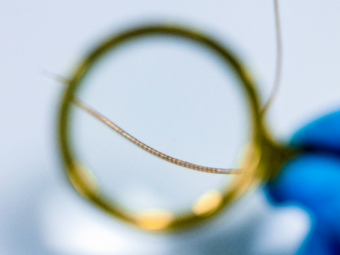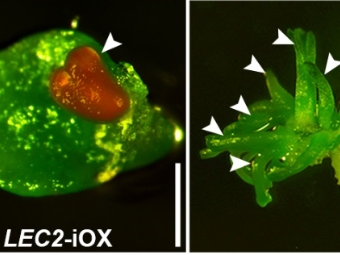|
|
|
|
|
з…§йЎҫз—…дәәеҰӮдҪ•жҺЁеҠЁдәәзұ»жј”еҢ–пјҹ |
|
|
и®әж–Үж ҮйўҳпјҡSocial Structure Facilitated the Evolution of Care-giving as a Strategy for Disease Control in the Human Lineage
жңҹеҲҠпјҡScientific Reports
дҪңиҖ…пјҡSharon E. Kessler, Tyler R.Bonnell, Joanna M. Setchell, Colin A. Chapman
еҸ‘иЎЁж—¶й—ҙпјҡ2018/09/27
ж•°еӯ—иҜҶеҲ«з Ғпјҡ10.1038/s41598-018-31568-2
еҺҹж–Үй“ҫжҺҘпјҡhttps://www.nature.com/articles/s41598-018-31568-2?utm_source=Other_website&utm_medium=Website_links&utm_content=RenLi-MixedBrand-multijournal-Multidisciplinary-China&utm_campaign=ORG_USG_JRCN_RL_article_promotion_sciencenet_Oct_2nd
еҫ®дҝЎй“ҫжҺҘпјҡhttps://mp.weixin.qq.com/s/dForV167C2GtmpS7lnQkRQ
ж №жҚ®гҖҠ科еӯҰжҠҘе‘ҠгҖӢеҸ‘иЎЁзҡ„дёҖйЎ№з ”з©¶Social Structure Facilitated the Evolution of Care-giving as a Strategy for Disease Control in the Human LineageпјҢйҡҸзқҖзӨҫдјҡзҪ‘з»ңеҸҳеҫ—ж—ҘжёҗеӨҚжқӮпјҢзӨҫдјҡдј ж’ӯз–ҫз—…зҡ„еЁҒиғҒдёҚж–ӯеўһеҠ пјҢз…§йЎҫз—…дәәеҸҜиғҪдҪҝеҸІеүҚдәәзұ»иғҪеӨҹйў„йҳІз–ҫз—…дј ж’ӯгҖӮ

еӣҫжәҗпјҡPexels
иӢұеӣҪжқңдјҰеӨ§еӯҰзҡ„Sharon KesslerеҸҠе…¶еҗҢдәӢдҪҝз”Ёи®Ўз®—жңәжЁЎеһӢжқҘжЁЎжӢҹжҠӨзҗҶеңЁеӣӣз§ҚдёҚеҗҢзӨҫдјҡзі»з»ҹдёӯзҡ„жј”еҸҳпјҢ他们йҮҚе»әдәҶеҢ…еҗ«50-200дәәзҡ„ж—©жңҹиғҪдәәпјҲHomo habilisпјүгҖҒзӣҙз«ӢдәәпјҲH. erectusпјүгҖҒжө·еҫ·е ЎдәәпјҲH. heidelbergensisпјүгҖҒе°је®үеҫ·зү№дәәпјҲH. neandertalensisпјүе’ҢжҷәдәәпјҲH. sapiensпјүзӨҫзҫӨгҖӮдҪңиҖ…иЎЁжҳҺпјҢеңЁжңүж•Ҳзҡ„жҠӨзҗҶзӯ–з•ҘзЎ®з«Ӣд№ӢеүҚпјҢз”ұзҲ¶жҜҚгҖҒе…„ејҹе§җеҰ№гҖҒе ӮпјҲиЎЁпјүе…„ејҹе§җеҰ№е’Ң其他家еәӯжҲҗе‘ҳиҙҹиҙЈзҡ„дәІеұһжҠӨзҗҶеҲ¶еәҰжңҖжңүеҸҜиғҪдҝғиҝӣжҠӨзҗҶеңЁдәәзұ»з§ҚзҫӨдёӯзҡ„жј”еҢ–гҖӮ他们и®ӨдёәиҝҷжҳҜеӣ дёә家еәӯжҲҗе‘ҳдјҡеҲҶжӢ…жҠӨзҗҶе’Ңзӣёе…із–ҫз—…жҡҙйңІзҡ„жҲҗжң¬пјҢд»ҺиҖҢйҷҗеҲ¶дёӘдҪ“зҡ„ж„ҹжҹ“йЈҺйҷ©гҖӮдёҺжӯӨеҗҢж—¶пјҢз–ҫз—…зҡ„дј ж’ӯйЈҺйҷ©дјҡйҷҗдәҺ家еәӯжҲҗе‘ҳеҶ…йғЁпјҢд»ҺиҖҢйҳІжӯўз–ҫз—…еҗ‘еӨ–дј ж’ӯгҖӮдёҖж—ҰзЎ®з«ӢдәҶжңүж•Ҳзҡ„жҠӨзҗҶзӯ–з•ҘпјҢжҠӨзҗҶзҪ‘з»ңе°ұеҸҳеҫ—жӣҙеҠ зҒөжҙ»пјҢдҝғиҝӣжҸҗй«ҳдәәзұ»зӨҫдјҡзі»з»ҹзҡ„еӨҚжқӮжҖ§е’ҢеӨҡж ·жҖ§гҖӮ

еӣҫ2пјҡе°ҸзӨҫзҫӨе№іеқҮжҷәеҠӣпјҲAпјүе’Ңз–ҫз—…дј ж’ӯпјҲBпјүйҡҸж—¶й—ҙзҡ„еҸҳеҢ–гҖӮз»ҝиүІиЎЁзӨәеҹәдәҺдәІеұһзҡ„зӨҫзҫӨпјҢи“қиүІиЎЁзӨәзҒөй•ҝзұ»еҹәеҮҶзәҝпјҢж·ЎйҮ‘иүІиЎЁзӨәдёӨдәәз»„пјҢзҙ«иүІиЎЁзӨәй—ҙжҺҘзҡ„дә’жғ зҫӨдҪ“гҖӮеӣҫжәҗпјҡKessler
дҪңиҖ…и®ӨдёәйҡҸзқҖеҸӨдәәзұ»зҡ„жј”еҢ–пјҢжҠӨзҗҶд№ҹдјҡдә§з”ҹйҖүжӢ©еҺӢеҠӣпјҢиҝҷеҸҜиғҪдҝғиҝӣжҹҗдәӣе…ёеһӢзҡ„дәәзұ»зү№еҫҒзҡ„жј”еҢ–пјҢжҜ”еҰӮж”ҜжҢҒз–ҫз—…иҜҶеҲ«е’ҢеҗҲдҪңжҠӨзҗҶзҡ„еҝғзҗҶгҖҒзӨҫдјҡдёҺи®ӨзҹҘзү№жҖ§пјӣдҪҝз–ҫз—…з—ҮзҠ¶жӣҙжҳ“дәҺеҸ‘зҺ°зҡ„з”ҹзҗҶзү№еҫҒпјӣд»ҘеҸҠеҜ№дјҡеңЁжҠӨзҗҶдәәдёӯй—ҙдј ж’ӯзҡ„з—…еҺҹдҪ“дә§з”ҹзӣёйҖӮеә”зҡ„е…Қз–«зі»з»ҹгҖӮ
еӣ жӯӨпјҢдҪңиҖ…жҖ»з»“иЎЁзӨәпјҢжҠӨзҗҶеҸҜиғҪжҳҜдёҺдәәзұ»з§ҚзҫӨжҲҗеҠҹзӣёе…ізҡ„еҝғзҗҶе’ҢиЎҢдёәзү№еҫҒзҡ„е…ій”®еӣ зҙ пјҢиҖҢжҠ‘еҲ¶з–ҫз—…дј ж’ӯзҡ„иғҪеҠӣеҸҜиғҪжҳҜдәәзұ»зӨҫдјҡеӨҚжқӮжҖ§жј”еҸҳзҡ„еҹәзЎҖгҖӮ
ж‘ҳиҰҒпјҡHumans are the only species to have evolved cooperative care-giving as a strategy for disease control. A synthesis of evidence from the fossil record, paleogenomics, human ecology, and disease transmission models, suggests that care-giving for the diseased evolved as part of the unique suite of cognitive and socio-cultural specializations that are attributed to the genus Homo. Here we demonstrate that the evolution of hominin social structure enabled the evolution of care-giving for the diseased. Using agent-based modeling, we simulate the evolution of care-giving in hominin networks derived from a basal primate social system and the three leading hypotheses of ancestral human social organization, each of which would have had to deal with the elevated disease spread associated with care-giving. We show that (1) care-giving is an evolutionarily stable strategy in kin-based cooperatively breeding groups, (2) care-giving can become established in small, low density groups, similar to communities that existed before the increases in community size and density that are associated with the advent of agriculture in the Neolithic, and (3) once established, care-giving became a successful method of disease control across social systems, even as community sizes and densities increased. We conclude that care-giving enabled hominins to suppress disease spread as social complexity, and thus socially-transmitted disease risk, increased.
йҳ…иҜ»и®әж–Үе…Ёж–ҮиҜ·и®ҝй—®пјҡhttps://www.nature.com/articles/s41598-018-31568-2?utm_source=Other_website&utm_medium=Website_links&utm_content=RenLi-MixedBrand-multijournal-Multidisciplinary-China&utm_campaign=ORG_USG_JRCN_RL_article_promotion_sciencenet_Oct_2nd
жңҹеҲҠд»Ӣз»ҚпјҡScientific Reports (https://www.nature.com/srep/) is an online, open access journal from the publishers of Nature. We publish scientifically valid primary research from all areas of the natural and clinical sciences.
The 2017 journal metrics for Scientific Reports are as follows:
•2-year impact factor: 4.122
•5-year impact factor: 4.609
•Immediacy index: 0.576
•Eigenfactor® score: 0.71896
•Article Influence Score: 1.356
•2-year Median: 2
пјҲжқҘжәҗпјҡ科еӯҰзҪ‘пјү
зү№еҲ«еЈ°жҳҺпјҡжң¬ж–ҮиҪ¬иҪҪд»…д»…жҳҜеҮәдәҺдј ж’ӯдҝЎжҒҜзҡ„йңҖиҰҒпјҢ并дёҚж„Ҹе‘ізқҖд»ЈиЎЁжң¬зҪ‘з«ҷи§ӮзӮ№жҲ–иҜҒе®һе…¶еҶ…е®№зҡ„зңҹе®һжҖ§пјӣеҰӮе…¶д»–еӘ’дҪ“гҖҒзҪ‘з«ҷжҲ–дёӘдәәд»Һжң¬зҪ‘з«ҷиҪ¬иҪҪдҪҝз”ЁпјҢйЎ»дҝқз•ҷжң¬зҪ‘з«ҷжіЁжҳҺзҡ„“жқҘжәҗ”пјҢ并иҮӘиҙҹзүҲжқғзӯүжі•еҫӢиҙЈд»»пјӣдҪңиҖ…еҰӮжһңдёҚеёҢжңӣиў«иҪ¬иҪҪжҲ–иҖ…иҒ”зі»иҪ¬иҪҪзЁҝиҙ№зӯүдәӢе®ңпјҢиҜ·дёҺжҲ‘们жҺҘжҙҪгҖӮ








